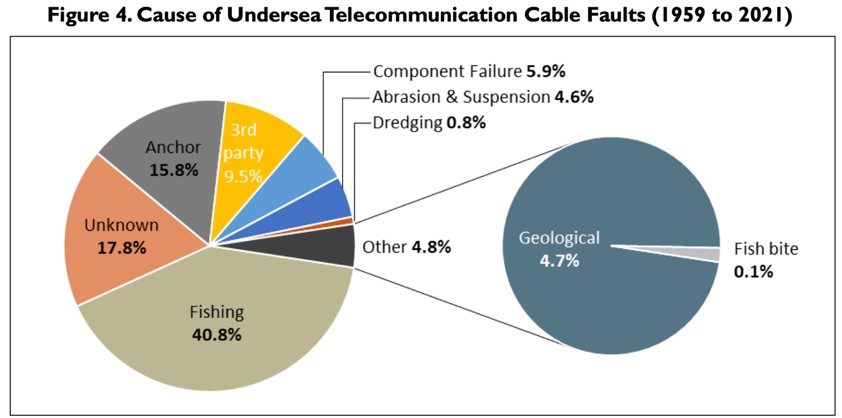Submarine cables are the unsung heroes of our digital age, quietly ensuring that nearly 99% of the world’s international data traffic flows seamlessly. These undersea marvels stretch across vast oceans, connecting continents and powering the internet, financial transactions, and global communications. Yet, they face significant threats from espionage and sabotage, making advanced protective technologies and strategies essential.
Espionage and Sabotage: Real-World Threats
Recent incidents have highlighted the vulnerability of submarine cables to intentional damage:
- Chinese Vessels Near Taiwan: Chinese ships have reportedly cut subsea cables in the Taiwan Strait, disrupting communications. This bold move was seen as China showcasing its ability to control Taiwan’s communications while also warning the U.S. about its strategic capabilities.
2. Russian Interference in Norway: Allegations of Russian tampering with submarine cables in Norwegian waters have raised concerns about potential espionage and data interception.
These incidents underscore the geopolitical significance of submarine cables and the need for robust defenses against such sabotage and espionage.
Unknown Reasons for Damage
Subsea cables are buried deep under the ocean, so it might come as a surprise that damage or complete cuts are expected. Given their strategic importance, the fact that they can be accessed and damaged easily highlights the need for better protective measures.
Source: Congressional Research Service
Technological Solutions for Enhanced Resilience
To address these risks, several advanced technologies and strategies are being deployed:
- Fiber Optic Advancements: Modern fiber optic technologies are enhancing the capacity and throughput of submarine cables, making them more resilient to damage and capable of transmitting larger volumes of data more securely.
- Real-Time Monitoring Systems: Implementing advanced monitoring systems allows for real-time detection of cable disturbances, enabling quicker responses to potential threats and minimizing downtime.
- Strategic Redundancy: Creating redundant pathways for data transmission ensures that if one cable is compromised, data can be rerouted through alternative cables, maintaining uninterrupted communications.
- Enhanced Cable Protection: Innovations in cable design, including reinforced materials and better burial techniques, provide physical protection against accidental or intentional damage.
SubCom: A Leader in Submarine Cable Technology
One of the key players in submarine cable technology is SubCom, a company recently acquired by Cerberus Capital Management. Headquartered in Eatontown, New Jersey, SubCom specializes in designing, deploying, and maintaining undersea fiber optic systems. With a history of delivering and supporting some of the world’s most advanced submarine cable networks, SubCom is at the forefront of ensuring the reliability and security of global communications.
As an industry veteran, David Coughlan leads SubCom as CEO, bringing extensive experience and a commitment to innovation in subsea communications. Under Cerberus’s ownership, SubCom aims to leverage strategic opportunities to enhance its leadership position in the market, focusing on deploying resilient and high-capacity cable systems.
SubCom has been generating more annual revenue than the cost of its acquisition by Cerberus. This impressive performance makes it a company to watch, as Cerberus has owned SubCom for about six years. The firm may seek to sell it for a substantial profit or take the company public as a way to exit, presenting a significant investment opportunity.
Investment Opportunities in Submarine Cable Technologies
Given submarine cables’ strategic importance and vulnerability, investing in companies and technologies that enhance their security and efficiency presents significant opportunities. Areas of interest for investors include:
- Innovative Cable Technologies: Companies developing advanced fiber optic technologies and enhanced cable protection systems.
- Real-Time Monitoring Solutions: Firms specializing in monitoring and detecting disturbances in submarine cables.
- Redundancy and Resilience: Projects focused on creating redundant communication pathways and improving the overall resilience of global data networks.
By focusing on these areas, investors can contribute to developing a more secure and robust global communications infrastructure, mitigating the risks of espionage and sabotage while ensuring the continued flow of international data.
Wrapping Up
The world of submarine cables might not be glamorous, but it is undoubtedly one of the most crucial. With increasing geopolitical tensions and the ever-present threat of espionage and sabotage, the need for advanced technological solutions is more pressing than ever. Companies like SubCom are leading the charge and making significant strides in protecting and enhancing these vital communication lines. For those with an eye on the future, investing in submarine cable technology offers a unique opportunity to be part of the backbone of global connectivity.


